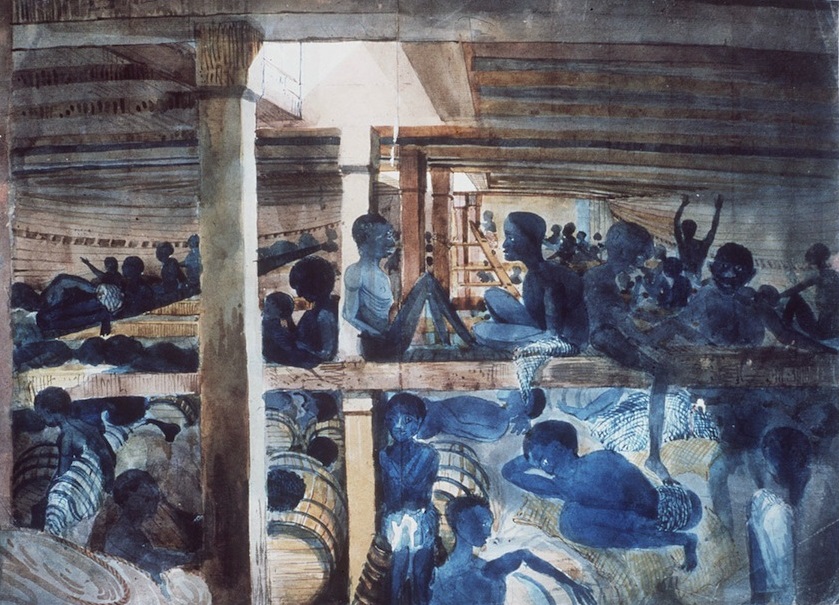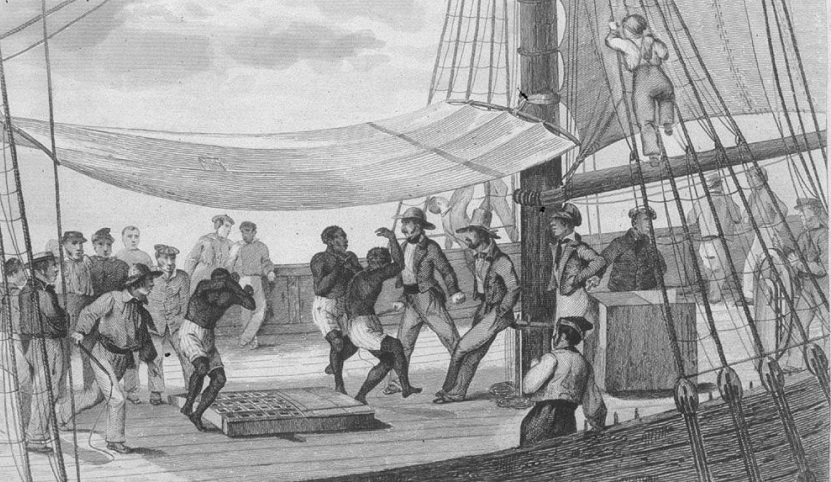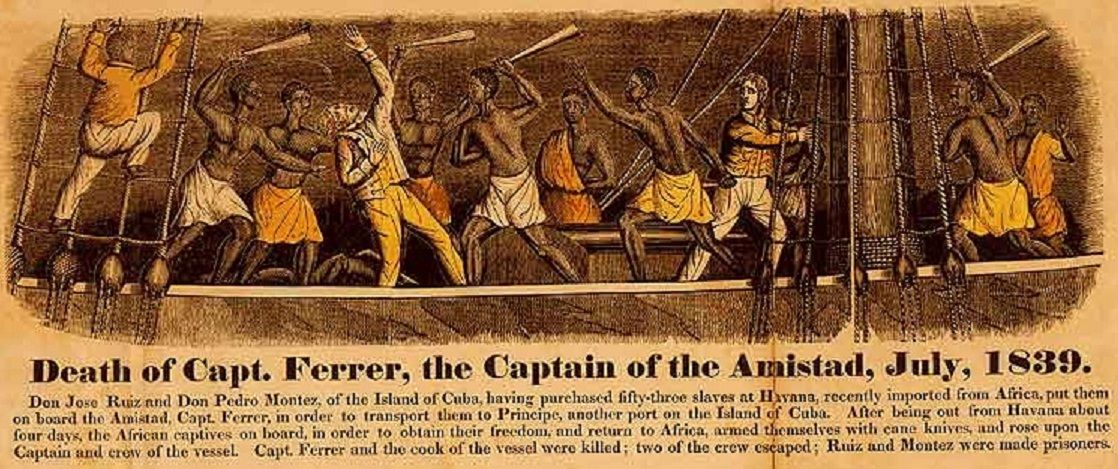
The Middle Passage

Introduction
What were conditions like on the voyage from Africa to America and the West Indies?
After you have studied this webpage, answer the question sheet by clicking on the 'Time to Work' icon at the top of the page.
Links:
The following websites will help you research further:
The Middle Passage: 60 second histories.
Short History Channel documentary on
the Middle Passage as shown in the TV series Roots.
Extra materials:
Crew of the slave ship Sally.
1 Instructions from the owners of the ship Africa to Captain George Merrick, 1774
We recommend you to treat the Negroes with as much care as safety will allow and let none of your men abuse them under any pretence whatsoever.
Be sure you see their victuals [food] well made and given them in due season...
We recommend you to make fires frequently in the Negroes' rooms...
We recommend mutton broth....
2 John Newton, Thoughts Upon the African Slave Trade, 1788
John Newton made three voyages as Captain of a slave ship (1750-54) and continued to invest in slaving voyages, even though he was a Christian and (after 1757) an Anglican priest. Only in 1788 did he publish his Thoughts Upon the African Slave Trade, which he said was: "a confession, which ... comes too late".
[The slaves were laid in] two rows one above the other, on each side of the ship, close to each other, like books upon a shelf. I have known them so close that the shelf would not easily contain one more And I have known a white man sent down among the men to lay them in rows to the greatest advantage, so that as little space as possible be lost...
And every morning perhaps more instances than one are found of the living and the dead ... fastened together.
3 Richard Drake, Revelations of a Slave Smuggler, 1860
Drake's autobiography claims that, in a career of 50 years in the slave trade, he was at different times overseer of a slave plantation, a slave-ship captain, and a slave factor. It is not clear whether it was written by Drake, or by the abolitionist Henry West. In amongst implausible stories of gold prospecting, being captured by an African tribe and visits with African kings along with the routine abolitionist plea for forgiveness for his crimes at the end are sections which seem to have been taken from a journal:
I am growing sicker every day of this business of buying and selling human beings for beasts of burden. On the eighth day [out at sea] I took my round of the half deck, holding a camphor bag in my teeth; for the stench was hideous. The sick and dying were chained together. I saw pregnant women give birth to babies whilst chained to corpses, which our drunken overseers had not removed. The blacks were literally jammed between decks as if in a coffin, and a coffin that dreadful hold became to nearly one half of our cargo before we reached Bahia [in Brazil].
Glossary:
Camphor: a very strong-smelling resin from
the camphor tree, used as an antiseptic, insect-repellant ... and to cover
bad smells.
4 Plan of The Brookes Slave Ship
Abolitionists used this plan of The Brookes (named after its Liverpool owner) to shock the public conscience about the conditions on board a slave ship. The plan shows how 292 enslaved Africans were packed onto the lower deck. What this illustration does not show is that a further 130 enslaved people lay side-by-side on a shelf which ran round the outside of the hull; the shelf gave the people underneath just 76 centimetres headroom for a journey which could take more than a month.

5 The Albanes, 1845
After the British abolished slavery in 1833, the Royal Navy hunted down slave ships and liberated the enslaved. This painting by Lieutenant Francis Meynell, a mate on the Royal Navy ship Albatross shows the hold of the Brazilian slave ship Albanes, after its capture by Albatross off Angola in 1845.

6 Captain Thomas Phillips, 1693-94
Thomas Phillips was 29 when he captained the disastrous voyage of the Hannibal. He kept a journal of the voyage, which was published in 1732.
We spent in our passage from St Thomas to Barbados two months eleven days ... in which time there happened much sickness and death among my poor men and Negroes, that of the first we buried 14, and of the last, 320, whereby the loss in all amounted to £6,560.
Story of the Hannibal
Useful excerpts from the Journal
7 Alexander Falconbridge, 1788
British surgeon Alexander Falconbridge served on four slave trade voyages 1780-87 before becoming an abolitionist and writing An Account of the Slave Trade on the Coast of Africa (1788).
Some wet and blowing weather having caused the port-holes to be shut, fluxes [dysentery] and fevers among the Negroes followed. I often went down among them, till at length their apartments became so excessively hot as to be only bearable for a very short time...
The floor of their rooms was so covered in the blood and mucus which had come from them because of the flux that it was like a slaughter-house.
8 Ottobah Cuguano, 1787
Captured into slavery at the age of 13, Ottobah Cuguano was first taken to a plantation in the West Indies. He was bought there in 1772 by an English merchant, who took him to England and gave him his freedom, after which he worked as a servant to a fashionable London artist. In the 1780s, Cuguano wrote Thoughts on the Evil and Wicked Traffic of Slavery in 1787.
There was nothing to be heard but the rattling of chains, smacking of whips, and the groans and cries of our fellow-men. Death was preferable to life, and a plan was made to blow up the ship, but we were betrayed.
9 Dr Thomas Trotter, 1783-84
Thomas Trotter joined the Royal Navy at age 19, became a surgeon's mate and eventually rose to be one of the leading ship's surgeons in the Navy. In 1783, however, he had signed up on the slave ship Brookes, an experience which shocked and sickened him. On 6 May 1790 he testified to the Select Committee of the House of Commons:
The slaves in the night were often heard making a ' howling melancholy kind of noise, something expressive of extreme anguish.
10 'Slaves dancing'
To keep them active, the enslaved were brought in small numbers up on deck from time to time and whipped to make them 'dance' (exercise). This engraving of a ship from Senegambia is from France Maritime, by Amèdèe Grehan, 1837.

11 Captain Japhet Bird, 1737
Bird made a number of slaving voyages. He described this incident on the slave ship Prince of Orange in a letter to The Boston Weekly News Letter (September 1737). He explained to the ship owner that he had, however, managed to sell those enslaved Africans he saved from the sea 'before any discovery of the injury the salt water had done them'.
To our great amazement above 100 men slaves jumped overboard, and it was with great difficulty we saved so many as we did; out of the whole we lost 33 good men slaves, who would not try to save themselves, but resolved to die and sunk directly down.
12 Richard Drake, Revelations of a Slave Smuggler, 1860
We had half the gang on deck today for exercise, they danced and sang, under the driver's whip, but are far from sprightly...
Last Tuesday the smallpox began to rage, and we hauled 60 corpses out of the hold... We bribed the blacks with rum in order to get their help in removing corpses. The sights which I witnessed may I never look on such again. This is a dreadful trade. Some of the blacks are raving mad, and screech like wild beasts.
Evaluating the Source:
Historians suspect that Drake's autobiography, edited and published after Drake's death by the
abolitionist Henry West, is largely fiction ... but that West seems to have
retained excerpts which appear to have come from a genuine journal.
Study this extract: fact or phony? Explain your judgement.
13 Mutiny on the Amistad
Slavery continued in the United States until 1863. In 1839 enslaved Africans on the ship Amistad killed the captain and the cook and ordered the crew to sail back to Africa. Instead, the crew sailed to New York, where the enslaved were arrested; they were freed, however, when they proved that they had been kidnapped.
